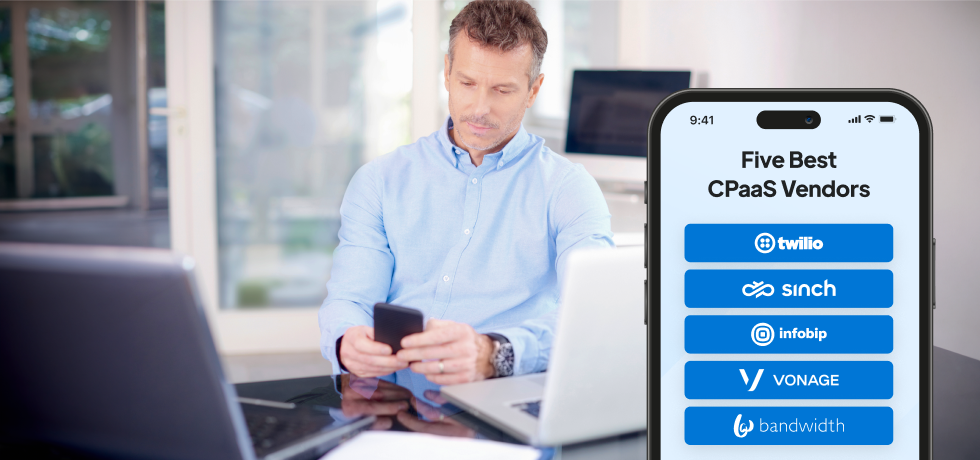
Bring Your Own Carrier (BYOC) is an innovative communications protocol that gives companies freedom in choosing their preferred telecommunications provider. Instead of applying a “rip and replace” strategy when switching to cloud-based communication, organizations are now able to bring their own telecom carriers (like Verizon, T-Mobile, or AT&T) into an existing cloud messaging platform.
In contrast, Bring Your Own CPaaS (BYO Communication Platform as a Service) involves businesses selecting and integrating a specific CPaaS provider’s technology (like Twilio, Sinch, or Infobip) into their existing infrastructure, offering customization in the communication services they deploy.
While BYOC focuses on carrier choice, BYO CPaaS emphasizes the selection and integration of the entire communication platform.
Companies already using a CPaaS provider can supercharge their tech stack with cloud-based texting functionalities that elevate business communication.
BYOC, as a broader concept, comes in to address the specific needs of each company according to their individual profile. It caters to their specificities, including geographical reach and desired service level standards. This, in time, will leave more room for innovation and a more effective resource allocation.

For the purposes of this article, we will be specifically discussing Bring Your Own Carrier (BYOC), exploring its impact and applications in modern communication systems.
The evolution of BYOC
As a telecom concept rooted in the need for flexibility and customization, BYOC grew from the understanding that a one-size-fits-all approach doesn’t suit the diverse needs of today’s businesses. As companies went global and communication got more complex, there was a demand for a model that could adapt and scale to these new needs.
The BYOC concept gained traction thanks to advancements like cloud-based communication and improved networking technologies. Cloud communications made it easier to integrate different carriers into a single system, making Bring Your Own Carrier a practical solution.
How does BYOC differ from traditional carrier models
Unlike traditional models that struggle with scalability, BYOC is naturally scalable. Businesses can easily adjust their carrier services based on their needs. This is especially beneficial for companies dealing with growth or changes in communication requirements.
While traditional carriers might excel in certain regions, they often lack a global presence. BYOC allows businesses to team up with carriers that have the best coverage in each region, blending global reach with local expertise. This is particularly important for companies operating internationally.
BYOC introduces a more cost-effective approach where businesses can take advantage of preferential rates and volume-based discounts they have negotiated with their existing telecom provider. This is unlike the approach of traditional text marketing services that involve fixed plans which can get costly for high-volume users. The BYOC model promotes cost efficiency and resource optimization.
How BYOC works
BYOC allows businesses to integrate external carriers into their communication infrastructure. It “plugs in” various carriers into a unified system, creating a versatile and adaptable network.
Carriers often excel in specific aspects of communication – calls, messages, or data. BYOC seamlessly integrates these carriers into a cohesive environment, ensuring they work together to fulfill diverse communication needs.
To make carriers speak the same language, BYOC establishes unified protocols. In a traditional setup, managing multiple carriers might be too complex. BYOC acts as an orchestrator, simplifying the complexities of coordinating different carriers and ensuring a smooth operation.
The beauty of BYOC lies in its scalability. Businesses can easily scale their communication infrastructure up or down by incorporating new carriers or retiring existing ones. If a carrier isn’t performing as it should or if there’s a need for change, BYOC facilitates the replacement or addition of carriers without disrupting the entire communication ecosystem.
Before fully deploying BYOC, businesses conduct interoperability testing. This phase ensures that all integrated carriers can interact seamlessly within the system.

Integrating BYOC with existing systems
First, conduct a thorough assessment of your communication needs. Consider requirements such as call volume, international reach, and preferred means of communication (voice, SMS, etc.).
After you’ve chosen the carrier(s) that match those requirements, BYOC establishes a unified protocol to define technical standards and specifications that will be adhered to by all integrated carriers.
To make sure carriers collaborate seamlessly within the system, interoperability tests are conducted. This involves testing various scenarios, starting with call routing, messaging etc.
The next stage handles configuration and deployment. Call handling procedures and other parameters are set in place, and once the system kicks off, you will be able to manage carriers based on their performance and on your business’ evolving needs.
Key benefits of BYOC
Bring Your Own Carrier (BYOC) represents a major shift in business communications because of its capacity to enhance cost-effectiveness and overall communication efficiency. Let’s explore its main benefits.
1. Cost savings and control over telecommunications expenses
Because of the ability to utilize existing carrier rates, BYOC is a master among cost-saving techniques. This model is particularly beneficial for businesses that have pre-established agreements with a carrier, allowing them to utilize these rates while leveraging the advanced features and capabilities of cloud-based text messaging platforms.
2. Flexibility and customization in choosing carriers
BYOC empowers businesses with the freedom to choose carriers based on their strengths and specialties. This “open menu” perspective lets you pick and combine carriers to create a customized solution tailored to your unique needs.
3. Improved call quality and reliability
BYOC introduces an era of improved call quality and reliability by integrating carriers seamlessly. It eliminates the setbacks that may arise in traditional setups. Your communication flows smoothly, enhancing the overall experience for both your team and your clients.
4. Scalability
Communication needs are as dynamic as the business they serve. BYOC is a scalability pro, allowing you to effortlessly scale your communication infrastructure up or down. Whether you’re expanding globally or streamlining operations, it ensures your telecommunications solution adapts to your business journey.
5. Global reach with local expertise
Traditional carriers may excel in specific regions but lack a global footprint. BYOC enables businesses to partner with carriers that offer the best coverage in each region, combining reach with local expertise.
Enterprises with an international presence stand to benefit most from this because they gain access to a more resilient communication infrastructure. If issues arise with one carrier in a specific region, others can compensate, ensuring continuity of services.
BYOC and CPaaS integration
BYOC and CPaaS are the dynamic duo of business communications. While Bring Your Own Carrier brings flexibility and carrier customization to the table, Communications Platform as a Service solutions provide a comprehensive set of communication tools and APIs.
How Textmagic’s BYOC complements CPaaS solutions
Textmagic supports BYOC integration via multiple CPaaS providers, including Twilio, Vonage, Bandwidth, Sinch, MessageBird, Infobip, Plivo, and Amazon SNS.
By integrating Textmagic into your chosen CPaaS provider, you can utilize the infrastructure, network capabilities, and services of your existing vendor. This means you can send messages using the routes, rates, and features offered by your CPaaS provider.
You will have access to all of Textmagic’s messaging features and tools, including our user interface, APIs, scheduling capabilities, and other functionalities that enhance the messaging experience. All this while using your own provider’s infrastructure.
Because you’re using your own CPaaS, you will benefit from any special pricing, volume discounts, or negotiated rates you have with your provider.
To integrate your existing CPaaS provider within the Textmagic platform, you will be using APIs and following the integration guidelines provided by your CPaaS vendor.
Considerations when implementing BYOC
To ensure a seamless integration when implementing BYOC, you must consider technical factors as well as strategic considerations. Let’s analyze both, then explore potential solutions to arising issues.
Challenges and potential pitfalls
Integrating carriers with diverse technologies and protocols can be complex. Different carriers often operate on distinct technology stacks, communication protocols, and standards. Carriers might use different communication protocols to facilitate the exchange of information. For instance, one carrier may use SIP for signaling, while another might have a proprietary protocol.
To overcome this challenge, we advise you to:
- Prioritize carriers that offer compatibility with common industry standards.
- Conduct detailed interoperability testing to ensure seamless integration and choose carriers that adhere to standards such as SIP (Session Initiation Protocol) for signaling in VoIP communication.
Balancing cost-effectiveness with quality of service involves minimizing expenses and ensuring a high standard of communication services, which often seems an unattainable goal.
The best way to do this is by:
- Opting for carriers offering transparent pricing models. Leverage the pay-as-you-go nature of BYOC to manage costs effectively.
- Using competition among carriers to negotiate pricing, service-level commitments, and contract terms. Secure customized agreements that reflect your unique requirements without compromising on quality.
Technical and regulatory considerations
When choosing your BYOC partners, consider their capacity to accommodate the growth of your business. Can they handle an increased volume of calls, messages, or data as your business grows? Look for partners with a proven track record of high uptime and minimal service disruptions. Also, consider factors such as call clarity, message delivery rates, and overall QoS metrics.
Carriers with flexible capacity options are best suited for growing businesses or businesses that need to scale down.
You should also ensure your existing communication infrastructure and systems are compatible with the BYOC model. Conduct a detailed assessment of your current communication infrastructure. Identify the components, systems, and technologies of your existing setup. This includes your Private Branch Exchange (PBX), messaging platforms, and any other communication tools.
Be aware that some degree of customization or configuration may be necessary to align your existing infrastructure with BYOC requirements. Work with your IT team or system administrators to make the necessary adjustments in settings, configurations, or system parameters.

BYOC for different business sizes
Small businesses often have limited budgets and resources. BYOC small business solutions should be scalable to accommodate growth but also cost-effective. Service providers need to offer flexible pricing models suitable for smaller communication volumes.
If you’re running a small business, opt for cloud-based BYOC solutions that offer scalability without the need for significant upfront investments. Cloud services allow businesses to scale resources as needed, paying only for what is used.
On the other hand, large enterprises often demand advanced communication features and customization options. BYOC solutions for enterprises should be able to support intricate communication workflows, advanced analytics, and tailored configurations to meet specific business requirements.
Large enterprises should look for BYOC solutions that offer robust APIs (Application Programming Interfaces) and integration capabilities since their IT ecosystems are often complex and include various applications and systems. An adaptable BYOC solution should integrate smoothly with CRM (Customer Relationship Management) systems, ERP (Enterprise Resource Planning) software, and other business-critical tools.
Successful BYOC implementation across different scales
The following case studies exemplify how BYOC can be successfully implemented across different scales, whether we’re referring to small enterprises seeking flexibility or large corporations demanding advanced features and adherence to compliance standards.
Case study 1
Business type: Boutique e-commerce store
Scale: Small business
Challenge:
A small e-commerce store faces challenges with its existing communication system, especially during peak sales periods. The fixed-cost model of traditional carriers is financially problematic, and the lack of flexibility prevents them from scaling communication resources based on demand.
BYOC solution:
Opting for a BYOC solution that allows them to integrate multiple carriers seamlessly. The selection will be based on cost-effectiveness and quality of service so that their communication strategy can be tailored to align with budget constraints.
Results:
- By choosing carriers strategically and adopting a pay-as-you-go model, the small business achieves significant cost savings compared to traditional fixed-cost carriers.
- During peak seasons, the business effortlessly scales its communication resources by adding more carriers, ensuring uninterrupted customer support and order processing.
- With the ability to choose carriers renowned for call quality, the store enhances its customer interactions, contributing to increased customer satisfaction.
Case study 2
Business type: Multinational financial services corporation
Scale: Large enterprise
Challenge:
A multinational financial services corporation with a scattered workforce faces problems within its communication infrastructure. The need for advanced features, customization options, and adherence to strict security and compliance standards triggers a reevaluation of their carrier strategy.
BYOC solution:
The enterprise adopts a comprehensive BYOC solution that includes the integration of carriers supporting advanced communication features such as video conferencing, multi-channel interactions, and collaboration tools.
This leads to customizing call flows, routing rules, and user experience according to specific business requirements. The chosen solution adheres to the highest security standards and compliance requirements in the financial industry.
Results:
- The enterprise adjusts its communication workflows, enhancing internal collaboration
and client interactions. - It also secures communication via adherence to rigorous measures, which are vital in the financial sector.
- BYOC brings about partnerships with carriers offering the best coverage in each region, ensuring global reach with local expertise.
- The enterprise scales its communication infrastructure to accommodate growth without compromising on quality.
Conclusion
Bring Your Own Carrier enables businesses to create a flexible and adaptable communication network by integrating external telecom carriers seamlessly into their existing network.
Its scalable nature and cost-saving features, combined with the possibility to choose carriers that offer the best coverage in each region, make BYOC the go-to solution for expanding businesses with diverse communication needs.
If you want to improve specific communication aspects, embrace a cost-effective model aligned with actual usage, or simply elevate your communication infrastructure without breaking the bank, BYOC is the ideal solution for your business. Whether you aim to enhance call quality, gain more control over telecommunications expenses, or introduce flexibility in carrier selection, BYOC stands out as your strategic business choice.
Frequently Asked Questions (FAQs)
BYOC allows companies to keep existing relationships with trusted carriers while taking advantage of cloud communication tools. It’s especially useful for businesses with custom compliance needs, specific rate agreements, or regional carrier preferences.
In traditional models, the cloud provider manages both the software and the carrier. With BYOC, the business brings its own carrier while using the cloud provider purely for software and features, offering more flexibility and control.
Not necessarily. While it’s common in enterprise settings, mid-sized businesses with international operations, strict security requirements, or legacy telecom contracts may also benefit from BYOC.
Challenges may include technical setup, ensuring compatibility between the carrier and platform, managing quality of service, and maintaining regulatory compliance. However, with proper planning, these can be effectively managed.
Yes. By maintaining direct contracts with carriers, businesses can often negotiate better rates, avoid markup fees from third-party platforms, and maintain cost visibility, especially with high-volume usage.
Related articles
Navigating CPaaS solutions: Top 5 CPaaS vendors in 2024
Communications Platform as a Service (CPaaS) stands ...
How to build and rebuild trust with your customers
Knowing how to build trust with customers is one of ...
O2O commerce for retail: Bridging online and offline experiences
O2O (online-to-offline) commerce has become a defini...
Effective abandoned cart SMS campaigns [with examples]
Cart abandonment has become one of the common source...
Top 12 customer contact channels to boost engagement in 2025
70% of customers are willing to purchase more from b...




